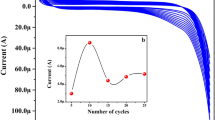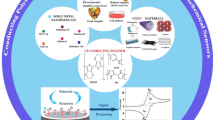Abstract
In this work, an electrochemical sensing platform is prepared for rifampicin determination based on multiwalled carbon nanotubes (MWCNTs) modified with meso-tetrakis(4-hydroxyphenyl)porphyrinato cobalt(II) (CoTHPP) nanocomposite (abbreviated as MWCNTs-CoTHPP). The material is characterized by different techniques such as UV–Vis, Fourier transform-infrared, Raman, transmission electron microscopy, scanning electron microscopy, and energy dispersive X-ray analysis. For the electrochemical sensing platform, the nanocomposite, MWCNTs-CoTHPP is immobilized on glassy carbon (GC) electrode (represented as GC/MWCNTs-CoTHPP) and applied for electrochemical recognition of rifampicin. It is found that the GC/MWCNTs-CoTHPP electrode facilitates the electrochemical oxidation of rifampicin with decreased overpotential in 0.1 M acetate buffer (pH 4.7). Further, GC/MWCNTs-CoTHPP exhibits broad calibration range (0.01 µM–5.0 mM), high sensitivity (217 µA mM−1 cm−2), high reproducibility (relative standard deviation = 4.83%, n = 6), and low detection limit (0.008 µM) for rifampicin determination. In addition, this method is successfully applied for real sample (rifampicin capsule) analysis with consistent results. The results suggest that MWCNTs-CoTHPP is a potential candidate for an effective, rapid, and simple electrochemical sensor to detect rifampicin in pharmaceutical formulations.
Graphical Abstract









Similar content being viewed by others

References
Hammam E, Beltagi A, Ghoneim M (2004) Voltammetric assay of rifampicin and isoniazid drugs, separately and combined in bulk, pharmaceutical formulations and human serum at a carbon paste electrode. Microchem J 77:53–62
Espinosa-Mansilla A, Valenzuela MA, de la Peña AM et al (2001) Comparative study of partial least squares and a modification of hybrid linear analysis calibration in the simultaneous spectrophotometric determination of rifampicin, pyrazinamide and isoniazid. Anal Chim Acta 427:129–136
Hahn Y, Shin S (2001) Electrochemical behavior and differential pulse polarographic determination of rifampicin in the pharmaceutical preparations. Arch Pharm Res 24:100–104
Rastgar S, Shahrokhian S (2014) Nickel hydroxide nanoparticles-reduced graphene oxide nanosheets film: layer-by-layer electrochemical preparation, characterization and rifampicin sensory application. Talanta 119:156–163
Fang P-F, Cai H-L, Li H-D et al (2010) Simultaneous determination of isoniazid, rifampicin, levofloxacin in mouse tissues and plasma by high performance liquid chromatography–tandem mass spectrometry. J Chromatogr B 878:2286
Srivastava A, Waterhouse D, Ardrey A, Ward SA (2012) Quantification of rifampicin in human plasma and cerebrospinal fluid by a highly sensitive and rapid liquid chromatographic–tandem mass spectrometric method. J Pharm Biomed Anal 70:523–528
Kawde A-N, Temerk Y, Farhan N (2014) Adsorptive stripping voltammetry of antibiotics rifamycin SV and rifampicin at renewable pencil electrodes. Acta Chim Slov 61:398–405
Ajayi RF, Sidwaba U, Feleni U et al (2014) Chemically amplified cytochrome P450-2E1 drug metabolism nanobiosensor for rifampicin anti-tuberculosis drug. Electrochim Acta 128:149–155
Leandro KC, Carvalho JM, Giovanelli LF, Moreira JC (2009) Development and validation of an electroanalytical methodology for determination of isoniazid and rifampicin content in pharmaceutical formulations. Braz J Pharm Sci 45:331–337
Lomillo MAA, Renedo OD, Martínez MJA (2005) Optimization of a cyclodextrin-based sensor for rifampicin monitoring. Electrochim Acta 50:1807–1811
de-Oliveira PR, Schibelbain AF, Neiva EG et al (2018) Nickel hexacyanoferrate supported at nickel nanoparticles for voltammetric determination of Rifampicin. Sens Actuators B 260:816–823
Tan ND, Yin JH, Yuan Y et al (2018) One-pot hydrothermal synthesis of highly fluorescent polyethyleneimine-capped copper nanoclusters for specific detection of Rifampicin Bull Korean Chem Soc 39:564–657
Amidi S, Ardakani YH, Amiri-Aref M et al (2017) Sensitive electrochemical determination of rifampicin using gold nanoparticles/poly-melamine nanocomposite. RSC Adv 7:40111–40118
Asadpour-Zeynali K, Mollarasouli F (2017) Novel electrochemical biosensor based on PVP capped CoFe2O4@CdSe core-shell nanoparticles modified electrode for ultra-trace level determination of rifampicin by square wave adsorptive stripping voltammetry. Biosens Bioelectron 92:509–516
Santos WJ, Sousa AL, Luz RC et al (2006) Amperometric sensor for nitrite using a glassy carbon electrode modified with alternating layers of iron (III) tetra-(N-methyl-4-pyridyl)-porphyrin and cobalt(II) tetrasulfonated phthalocyanine. Talanta 70:588–594
Collman JP, Marrocco M, Denisevich P et al (1979) Potent catalysis of the electroreduction of oxygen to water by dicobalt porphyrin dimers adsorbed on graphite electrodes. J Electroanal Chem 101:117–122
Quintino MS, Winnischofer H, Araki K et al (2005) Cobalt oxide/tetraruthenated cobalt-porphyrin composite for hydrogen peroxide amperometric sensors. Analyst 130:221
Lennox JC, Murray RW (1977) Chemically modified electrodes. J Electroanal Chem 78:395–401
Kadish KM, Davis DG (1973) Electrochemical studies of metalloporphyrins. Ann NY Acad Sci 206:495–503
Biesaga M, Pyrzyńska K, Trojanowicz M (2000) Porphyrins in analytical chemistry. a review. Talanta 51:209–224
Dobson D, Saini S (1997) Porphyrin-modified electrodes as biomimetic sensors for the determination of organohalide pollutants in aqueous samples. Anal Chem 69:3532–3538
Sonkar PK, Prakash K, Yadav M et al (2017) Co(II)-porphyrin-decorated carbon nanotubes as catalysts for oxygen reduction reactions: an approach for fuel cell improvement. J Mater Chem A 5:6263–6276
Lu W, Li N, Chen W, Yao Y (2009) The role of multiwalled carbon nanotubes in enhancing the catalytic activity of cobalt tetraaminophthalocyanine for oxidation of conjugated dyes. Carbon 47:3337–3345
Gao C, Jin YZ, Kong H et al (2005) Polyurea-functionalized multiwalled carbon nanotubes: synthesis, morphology, and Raman spectroscopy. J Phys Chem B 109:11925–11932
Sonkar PK, Ganesan V, Sen Gupta SK et al (2017) Highly dispersed multiwalled carbon nanotubes coupled manganese salen nanostructure for simultaneous electrochemical sensing of vitamin B2 and B6. J Electroanal Chem 807:235–243
Zeng B, Wei S, Xiao F, Zhao F (2006) Voltammetric behavior and determination of rutin at a single-walled carbon nanotubes modified gold electrode. Sens Actuators B 115:240–246
Milgrom LR (1983) Synthesis of some new tetra-arylporphyrins for studies in solar energy conversion. J Chem Soc Perkin Trans 1:2535–2539
Wu C, Wang Z, Wang L et al (2012) Sustainable processing of waste plastics to produce high yield hydrogen-rich synthesis gas and high quality carbon nanotubes. RSC Adv 2:4045–4047
Bansal M, Srivastava R, Lal C et al (2010) Change in conformation of polymer PFO on addition of multiwall carbon nanotubes. Nanoscale 2:1171–1177
Shahid MM, Rameshkumar P, Pandikumar A et al (2015) An electrochemical sensing platform based on a reduced graphene oxide–cobalt oxide nanocube@ platinum nanocomposite for nitric oxide detection. J Mater Chem A 3:14458–14468
Kim H, Kosuda KM, Van Duyne RP, Stair PC (2010) Resonance Raman and surface-and tip-enhanced Raman spectroscopy methods to study solid catalysts and heterogeneous catalytic reactions. Chem Soc Rev 39:4820–4844
Boucher L, Katz J (1967) The infared spectra of metalloporphyrins (4000-160 cm–1). J Am Chem Soc 89:1340–1345
Shimomura ET, Phillippi MA, Goff HM et al (1981) Infrared spectroscopy of oxidized metalloporphyrins: detection of a band diagnostic of porphyrin-centered oxidation. J Am Chem Soc 103:6778–6780
Zhang X, Zhang Y, Jiang J (2005) Infrared spectra of metal-free, N′,N-dideuterio, and magnesium porphyrins: density functional calculations. Spectrochim Acta A 61:2576–2583
Hai C, Shirai T, Fuji M (2013) Fabrication of conductive porous alumina (CPA) structurally modified with carbon nanotubes (CNT). Adv Powder Technol 24:824–828
Cruz-Silva E, Cullen DA, Gu L et al (2008) Heterodoped nanotubes: theory, synthesis, and characterization of phosphorus—nitrogen doped multiwalled carbon nanotubes. ACS Nano 2:441–448
Lee Y-W, An G-H, Lee S et al (2016) Synergistic incorporation of hybrid heterobimetal–nitrogen atoms into carbon structures for superior oxygen electroreduction performance. Catal Sci Technol 6:2085–2091
Grassi G, Scala A, Piperno A et al (2012) A facile and ecofriendly functionalization of multiwalled carbon nanotubes by an old mesoionic compound. Chem Commun 48:6836–6838
D’Souza F, Villard A, Van Caemelbecke E et al (1993) Electrochemical and spectroelectrochemical behavior of cobalt(III), cobalt(II), and cobalt(I) complexes of meso-tetraphenylporphyrinate bearing bromides on the. beta.-pyrrole positions. Inorg Chem 32:4042–4048
Bard AJ, Faulkner LR, Leddy J, Zoski CG (1980) Electrochemical methods: fundamentals and applications. Wiley, New York
Hammam E, Beltagi AM, Ghoneim MM (2004) Voltammetric assay of rifampicin and isoniazid drugs, separately and combined in bulk, pharmaceutical formulations and human serum at a carbon paste electrode. Microchem J 77:53–62
Sonkar PK, Ganesan V, Prajapati A (2016) Polymeric Co(salen) scaffold for the electrochemical determination of acetaminophen in pharmaceutical sample. Ionics 22:1741–1749
Tyszczuk K, Korolczuk M (2009) New protocol for determination of rifampicine by adsorptive stripping voltammetry. Electroanalysis 21:101–106
Jain P, Pathak VM (2013) Development and validation of UV-visible spectrophotometric method for estimation of rifapentine in bulk and dosage form. Der Pharma Chem 5:251–255
Mohamed MA, Shantier SW, Mohamed MA et al (2015) Spectrophotometric method for the simultaneous determination of isoniazid and rifampicin in bulk and tablet forms. Int J Pharm Sci Rev Res 32:154–156
Benetton SA, Kedor-Hackmann ERM, Santoro MIRM., Borges VM (1998) Visible spectrophotometric and first-derivative UV spectrophotometric determination of rifampicin and isoniazid in pharmaceutical preparations. Talanta 47:639–643
Sonkar PK, Ganesan V, Gupta R, Yadav DK (2016) Simple route to anchor silver nanoparticles into thiol-functionalized mesoporous silica: synthesis, characterization and electrochemical applications. J Nanopart Res 18:297–307
Acknowledgements
The authors gratefully acknowledge the financial support by DST (SR/NM/NS-2012/2013(G)), New Delhi, India. We are pleased to thank Prof. R.K. Singh, Banaras Hindu University for Raman characterization and Dr. S.A. John, Gandhigram Rural University for SEM and useful suggestions. MS sincerely thanks Science and Engineering Research Board (EMR/2016/004016) for the financial support. KP thanks Ministry of Human Resource Development, India for Senior Research Fellowship.
Author information
Authors and Affiliations
Corresponding author
Electronic supplementary material
Below is the link to the electronic supplementary material.
Rights and permissions
About this article
Cite this article
Sonkar, P.K., Yadav, M., Prakash, K. et al. Electrochemical sensing of rifampicin in pharmaceutical samples using meso-tetrakis(4-hydroxyphenyl)porphyrinato cobalt(II) anchored carbon nanotubes. J Appl Electrochem 48, 937–946 (2018). https://doi.org/10.1007/s10800-018-1221-3
Received:
Accepted:
Published:
Issue Date:
DOI: https://doi.org/10.1007/s10800-018-1221-3



